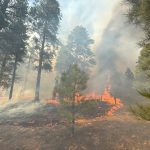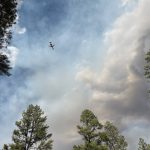
Where’s the juice? 500 MW line open for business
WINDOW ROCK
With the first annual payment of a $1.9 million “transmission charge,” the Navajo Nation is securing the rights to use or sell access to 500 megawatts of electrical transmission capacity for 35 years starting Dec. 23.
This is per an agreement negotiated with the U.S. Bureau of Reclamation in 2017 as part of the lease extension for the Navajo Generating Station, which stopped producing electricity in November.
When asked if there were any buyers lined up for the 500-MW line, President Jonathan Nez stated that any potential partners would have to be vetted by the Háyoolkáál Work Group.
“As of now, we have not formally entertained any proposals,” he said.
As of right now the transmission line is dormant.
However, annual revenue projections for the 500-MW line in 2020 and 2021 range from $888,000 for 20 percent utilization to $7.3 million for 100 percent use.
Those estimated revenues depend on making the line available to energy companies who want to rent it to transmit electricity.
Meanwhile, according to a Division of Natural Resources report, an outside “middleman” company will be brought in to assist the Nation in marketing and managing the operation of 500-MW line.
DNR began looking for a “scheduling and managing entity” in 2018 and issued a request for proposals.
The report says DNR selected a portfolio management company headquartered in Florida to provide the “wholesale electric market scheduling and trading services,” and states that they are in contract negotiations.
‘Sold on the open market’
Speaker Seth Damon confirmed the rights of way to the transmission line will be “sold on the open market” by the wholesaler to “anyone who wants to transfer electric power through them,” from 50 to 500 megawatts.
Prospective buyers would have to be approved by the Resources and Development Committee after being screened by Háyoolkáál.
He added that it would probably be the “SRPs (Salt River Project) or APS (Arizona Public Services) of the world” or third-party contractors who work for those types of companies who will rent the lines, at least initially.
“There is a lot of potential for the Nation but you have to do it right and you have to make sure you bring people in that aren’t just wanting to make money off of the Nation,” said Damon.
In the future, Navajo power sources such as solar or wind farms can also make use of the 500-MW line to transmit and sell power to other areas.
Damon said there are opportunities for NTUA as well as individual chapters to build sources of energy to feed into the transmission line, but that will also require power line infrastructure to “plug in” to the 500-MW line, which is very expensive.
“In the first couple of years because Navajo doesn’t have anything to generate power and put power into these lines, we’re going to put it on the market,” he said.
Damon said the whole idea is to save the money earned from outside energy companies who want to use the 500-MW line and apply it to Navajo energy projects that can eventually supply it.
“That’s what President Nez wants to do is create sources to feed into transmission lines and start selling power to the big guys,” said Damon.
Regardless of who would like to do what with the potential revenues, however, Damon said that a plan of operation for the 500-MW line has to be developed by DNR and the Council’s Resources and Development Committee.
A $1.9 million advance
Damon said that seeing the Dec. 4 Department of Interior Bureau of Reclamation bill addressed to the Navajo Nation for the first $1.9 million was a big surprise to him.
Apparently, the initial agreement with the BOR never specified where the payment would come from, just that the Navajo Nation was responsible for making it.
“A month ago no one knew about this on this side of the street,” said Damon. “No one from DNR or the Háyoolkáál group came over and said, ‘We need to make this payment.’ No one stepped up. If we didn’t make this payment, we could have lost out.”
As part of the extension lease, NGS owners agreed to cover the Nation’s operation and maintenance costs related to the 500-MW line for 10 years and the Navajo Nation is responsible for capital costs, also known as the transmission charge, at an annual rate of $1.9 million.
After the first 10 years, the Nation will be responsible for both operations and maintenance and capital costs.
Damon said that the legislation created to pay the bill, sponsored by himself and Delegate Nathanial Brown, had to be turned around quickly because the payment is due on Jan. 3, 2020.
In special sessions on Dec. 19, the Naabik’iyati Committee and Council passed a bill (No. 0373-19) that advanced a supplemental appropriation of $1.9 from the Nation’s Undesignated, Unreserved Fund Balance, which stood at $16.8 million as of Dec. 6.
“The $1.9 million is an advance payment that will be repaid,” said Damon.
Both the Budget and Finance Committee, which approves fund management plans, and RDC, which sets policy concerning the Nation’s resources and energy development, approved the legislation prior.
The bill also designates that the revenues generated by the 500-MW transmission line will go to an interim “500 MW Revenue and Repayment Fund” within DNR that will pay back the first $1.9 million, plan for future annual payments, and fund (unspecified) “energy-related” projects that have been approved by RDC.
‘Both sides of the street’
While President Nez would like to see future revenues from the line earmarked for renewable energy projects, at this moment there is no guarantee of that because Council is still debating how to move forward with the Nation’s Energy Policy, last updated in 2013.
Nevertheless, in a Sunday news release Nez said, “the acquisition of the 500 megawatts places the Navajo Nation in the driver seat to determine its own energy future in accordance with the Nez-Lizer administration’s Háyoolkáál proclamation,” that prioritizes renewable energy development.
To date, the president’s office says that the Háyoolkáál Work Group will continue serving as the primary clearinghouse for energy projects while awaiting the establishment of an operational Navajo Nation Energy Office.
Members of the work group, including Economic Development Division Director J.T. Willie, have said that the they have been “vetting” energy projects, but very little has been revealed to the public about what those projects are.
Another snafu? While the energy office already has funds appropriated to it ($100,000 in 2018 and $663,000 for 2020), it has yet to be created through legislation.
In the fall session, the Council tabled the energy office legislation (0273-19) to the winter session, but now it looks like that will be delayed again, because the “energy conference” planned to discuss the energy policy and the energy office has now been put off until March.
Ultimately, Damon said RDC and Budget and Finance have the final authority over what happens with the energy office, the 500-MW line, the revenues it generates, and how they will be collected, administered, and spent.
He says if DNR doesn’t work with RDC and B&F “they are not going to get anywhere.”
“You have to work with both sides of the street,” he said.








 Highway 264,
Highway 264, I-40, WB @ Winslow
I-40, WB @ Winslow